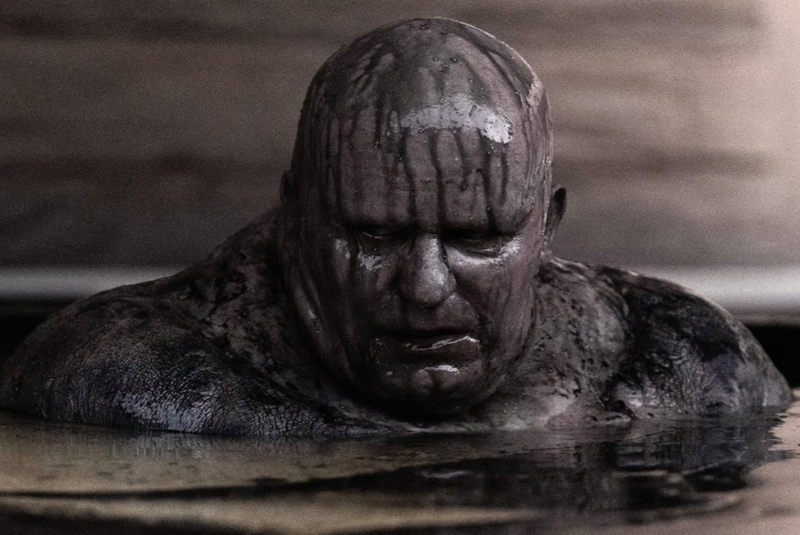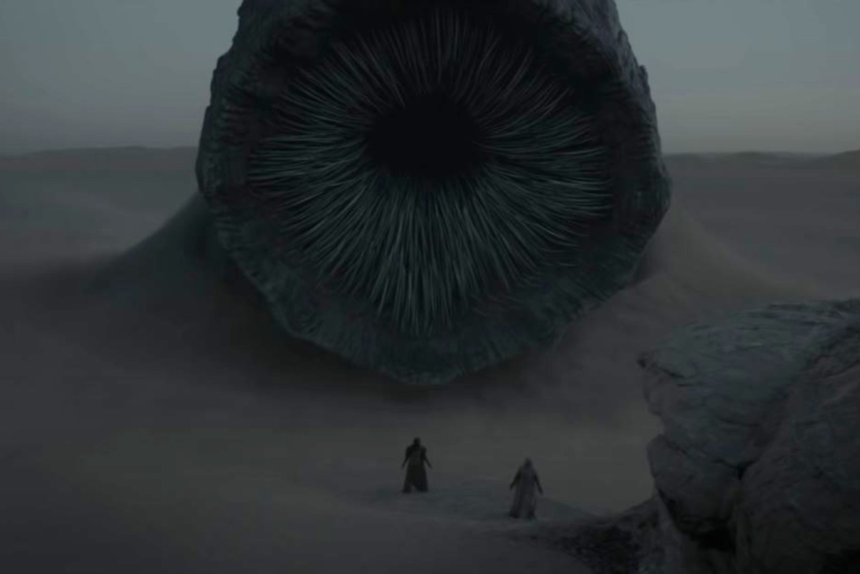A stunning new film adaptation of Frank Herbert’s science fiction epic, Dune, recently graced America’s silver screens. The talented Quebecois director Denis Villeneuve has fully utilized modern cinematic technology to bring to life Herbert’s bizarre story of a far-flung neofeudal humanity existing some 20,000 years in the future. Villeneuve’s adaptation of these best-selling science fiction novels of all time is the first to remain fully faithful to Herbert’s vision.
But what is this vision? The creative imagination Herbert displayed is so fecund and influential on the entire genre of science fiction—especially on George Lucas’s Star Wars films—that one is tempted to look for the meaning of Dune on its flashy surface. Herbert depicts a humanity that is at once high tech and atavistic, traveling the stars, and yet locked in feudal, hierarchical societies. It has rejected artificial intelligence and advanced computing, due to their deleterious effects on human life. A neo-medieval guild system segregates professions that are by necessity genetically, educationally, and pharmaceutically specialized. Space travel is impossible without Spacing Guild navigators, who are addicted to the “spice melange” drug. Computing is impossible without the Mentats, human thinking machines addicted to the drug “sapho,” who serve as advisors to barons and dukes, and an emperor who rules over their interstellar fiefdoms.
Focusing on these surface details misses Dune’s thematic core, which is fundamentally theological. Herbert, an ex-Catholic, published Dune in 1965, the concluding year of the Second Vatican Council, during which a progressive spirit of reform was unleashed within the Church. A school of liberal theology dubbed “modernism” that had been suppressed by conservative popes during the previous century was resurrected in a new generation of neo-modernist theologians who took the guiding reins of the Council. Their aim was, in the words of the excommunicated modernist priest Alfred Loisy, “to adapt Catholicism to the intellectual, moral, and social needs of today.”
The six Dune novels are a product of this zeitgeist. Herbert used his science fiction to capture the modernist, existentialist theology dominant in the 1960s and to project its consequences onto the far future. It is a future in which truth is subjective and religion is a tool disconnected from spiritual reality. There, dogma evolves and adapts to the needs of the material world, and the gene replaces the soul.
Though modernism’s particular effect spurred changes within the Catholic Church during Vatican II, its principles are behind a continued progressive trend in all Christian denominations. This trend manifests itself in skepticism about the literal truth of the Gospels and the unchanging nature of Christ’s teaching. Dune, and its attractive current film iteration, is a cultural product of this leftward theological drift, which has been called the “spirit of Vatican II.”
Agnosticism, evolutionism, and subjectivism are three characteristics of modernism identified by Pope Pius X in his 1907 encyclical Pascendi Dominici Gregis (“Feeding the Lord’s Flock”). Agnosticism is reflected in the modernist idea that spiritual truth is beyond the capacity of human knowledge to comprehend and human words to express. In this view, all human religions are equal, in that they are imperfect attempts made by humans to commune with God. As a result, dialogue with other religions is pursued rather than evangelization and proselytization.
In Dune, the results of agnosticism are taken to extremes through pan-galactic ecumenism. The authoritative scripture is the Orange Catholic Bible. This scripture fuses all major religions, listed in the novels as: Mahayana Christianity, Zensunni Catholicism, Buddislam, and an Islamic offshoot called the Maometh Saari, Maometh being the “Third Muhammed.” The priestly class is the all-female order of the Bene Gesserit—a portmanteau of the Benedictine and Jesuit Catholic orders. Since the ultra-liberal modern-day Jesuits routinely call for the ordination of women within their flagship magazine America, the Bene Gesserit are another sign of Herbert taking progressive theological trends to their logical conclusion.
The focus of Dune’s religion is primarily material. The Bene Gesserit use a neurolinguistic trick called “The Voice” to command people to do their bidding. They are able to enter Zen-like meditative trances that give them perfect control over every cell of their bodies, allowing them to perform lethal physical feats. The Bene Gesserit are the inspiration for the Jedi of Lucas’s Star Wars franchise, whose religion, “the Force,” also boils down to the cellular level where “midi-chlorians” are responsible for the Jedi’s seemingly magical powers.

above: Timothée Chalamet as Paul Atreides and Charlotte Rampling as Reverend Mother Mohiam in the 2021 film Dune (Warner Bros.)
Other material aspects of this religion are seen in the prayers of its followers, which aren’t addressed to any god. Instead, the primitive Fremen tribes of the desert planet Arrakis pray to ancestor spirits and the giant sandworms, while the more sophisticated denizens of the empire utter self-affirming mantras. The calming “Litany Against Fear” is often chanted: “Fear is the mind-killer. Fear is the littledeath that brings total obliteration. I will face my fear.”
Note the suggestion in the “Litany of Fear” that “death brings total obliteration.” There is no spiritual afterlife in the religion of Dune. Instead, the Bene Gesserit are focused on achieving immortality through the human gene pool, by creating through breeding the “Kwisatz Haderach.” This evolved human will be able to see into the future as well as into the genetic memory of humanity’s past. (Herbert appears to have borrowed the term from a phrase in the Hebrew Kabbalah meaning “Leap of the Way.”)
Evolution is the second aspect of theological modernism that Pius X identified. One of modernism’s fundamental principles is “the possibility, the necessity, and the legitimacy of evolution in understanding the dogmas of the Church,” the modernist Loisy said. Pius X explicates this further in Pascendi:
In this way they pass to what is practically their principal doctrine, namely, evolution. To the laws of evolution everything is subject under penalty of death—dogma, Church, worship, the Books we revere as sacred, even faith itself.
A son of one of the noble houses, Paul Atreides, emerges in Dune as the evolved Kwisatz Haderach, and he uses his precognitive powers to triumphantly overthrow the galaxy’s villainous emperor. This plot from Dune’s first book is as far as Villeneuve will go in his two-part film adaptation, and for good reason. Things take a decidedly darker turn in the remaining five books. In Herbert’s second book, Dune Messiah, Atreides’ ability to see the future has disastrous consequences for the universe. He foresees that in conquering its environment, humanity has grown weak and complacent. Evolution has stalled without selection pressure; there is no Darwinian “survival of the fittest” to spur on the next stage of development. Only on the harsh desert planet of Arrakis have the weak been culled.
Imposing himself as a kind of theological, environmentalist messiah, Atreides establishes a new galactic headquarters on Arrakis, with himself as the head of a reformed religion focused on ecological balance. Though humanity seeks peace and attempts to rule over its environment, Atreides believes that humanity needs struggle and should be subject to its environment, not a ruler over it. Thus, he sends the Freman out on a murderous jihad to slaughter and pillage the rest of the civilized universe in the name of improving the quality of the human stock.
Readers may recognize the ecological focus of progressive theology, as shown in Pope Francis’s 2015 encyclical Laudato si’, which again shows Herbert’s prescience in projecting progressive theological trends onto the future.
In subsequent books, Children of Dune and God Emperor of Dune, Atreides’s son, Leto II, takes a final evolutionary step and genetically merges with the planet’s giant sandworms to extend his lifespan thousands of years. This will enable him to exercise perfect control over humanity’s evolutionary development as a living godhead controlling a galactic theocracy.
Here Herbert’s vision in Dune is admittedly bizarre, but it references the modernist theological views in vogue during the ’60s, especially those of the French Jesuit priest Pierre Teilhard de Chardin. De Chardin, whose evolutionary theological books were condemned by the Vatican, saw humanity, the Church, and the entire universe moving toward a final evolutionary “Omega Point” in which the “Cosmic Christ” would be realized. Through the humanworm hybrid of God Emperor Leto II, Herbert seems to be suggesting an end point far stranger than anyone else could have imagined.
The third aspect of modernism Pius X identified is “vital immanence,” which may be simply termed subjectivism. This idea, derived from the philosophies of Hegel and Kant and the 20th century philosophy of existentialism, is that human beings are trapped within their own minds and cannot truly know reality, except as mediated by their own individual perceptions. Thus each person, in order to live authentically, must break free of hidebound dogma and tradition. These are merely futile attempts to impose rationality on the irrational nature of existence as it is lived it moment to moment. “Man is nothing else but what he makes of himself,” as the existentialist philosopher Jean-Paul Sartre put it.
In Dune, the Atreides family is of Greek origin and traces its lineage back to King Agamemnon through a Latin strain. Herbert thus uses the Atreides family as a stand-in for Western civilization itself, particularly its positive elements: honor, courage, faithfulness, duty, and republicanism. Their enemies are the Harkonnens, a barbaric Northern European house (Herbert derived the name “Harkonnen” from Finnish). Herbert uses the Harkonnens, particularly the fat and corrupt Baron (played with impressive malevolence by Stellan Skarsgård in Villeneuve’s film) to represent the negative elements of Western civilization: treachery, deceit, immorality, genocide, and tyranny.

above: Stellan Skarsgård as Baron Vladimir Harkonen in the 2021 film Dune (Warner Bros.)
The good guys lose in Dune: Baron Harkonnen succeeds in wiping them all out except for Paul Atreides and his mother. Western civilization’s positive elements are overpowered by the negative ones. Atreides turns the tables and defeats the Harkonnens only by a radical creative imaging of himself, of his religion, and of society. The story of Atreides in Dune is “vital immanence” dramatically personified.
“Science fiction is the most important literature in the history of the world, because it’s the history of ideas, the history of our civilization birthing itself,” according to author Ray Bradbury. If there’s any truth to this statement, it certainly applies to Dune. Most readers and filmgoers entertained by Dune’s story may not be aware of the modernist ideas contained within Herbert’s novels, but as it says in Scripture, “A little leaven corrupteth the whole lump.”
Image Credit:
above: characters confront a sandworm in a still from Denis Villeneuve’s 2021 film adaptation of Frank Herbert’s 1965 sci-fi novel Dune (Warner Bros.)
